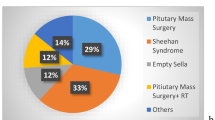Summary
The object of the study was to see whether maintenance of serum estradiol levels corresponding to the early and mid-follicular phase can prevent the gonadotrophin increase following ovarectomy. We also wanted to study the effect on LH and FSH of an additional dose of 1 mg dose of 1 mg norethisterone acetate administered for 10 days during each month. In 22 women with normal cycles 1 mg of estradiol benzoate was injected i.m. at the time of ovariectomy. From the first post-operative day onwards they received daily doses of 2 mg estradiol and 1 mg estriol in the form of micronized tablets. From the 41st to the 50th day and again from the 69th to the 78th day the patients received additional daily doses of 1 mg norethisterone acetate. LH, FSH, estradiol-17β, (E2) progesterone (P), testosterone (T), and prolactin (PRL) were measured in intervals of 2–17 days.
Even though the estradiol mean values remained constant in the range of 65–115 pg throughout the period under observation, the LH mean levels increased continuously from 8 to a maximum of 23.9 mU/ml, and the FSH mean level from a pre-operative value of 6–48.0 mU/ml on the 85th day. On the 7th day after the last administration of noresthisteroneacetate LH was slightly depressed while FSH continued to rise slightly. Both FSH and LH are negatively correlated with E2 and this inverse correlation becomes even more pronounced the more time has elapsed after surgery.
These findings suggest that not only the estrogens inhibit FSH and LH but also other steroids and/or nonsteroidal ovarian inhibiting factors.
Similar content being viewed by others
References
Bartl W, Kemeter P, Friedrich F, Seidl A (1982) Über die zyklische Behandlung klimakterischer Beschwerden mit genuinen Östrogenen. Gynaecol Rundsch 22:23–48
Bernard J, Psychoyos A (1977) Inhibitory effect of follicular fluid on RNA synthesis of rat granulosa cells in vitro. J Reprod Fertil 49:355–357
Chari S, Duraiswami S, Franchimont P (1978) Isolation and characterization of inhibin from bull seminal plasma. Acta Endocrinol (Copenh) 87:434–448
Chari S, Hopkinson CRN, Daume E, Sturm E (1979) Purification of “inhibin” from human ovarian follicular fluid. Acta Endocrinol (Copenh) 90:157–166
Chari S, Aumüller G, Daume E, Sturm G, Hopkinson C (1981) The effects of human follicular fluid inhibin on the morphology of the ovary of the immature rat. Arch Gynecol 230:239–249
De jong FH, Sharpe RM (1976) Evidence for inhibin-like activity in bovine follicular fluid. Nature 263:71–72
Franchimont P, Demoulin A, Hazee-Hagelstein MT, Verstraelen-Proyard J, Bourguignon JP (1979) Control of gonadotrophin secretion by inhibin. Acta Endocrinol [Suppl] (Copenh) 225
Karsch FJ, Weick RF, Hotchkiss J, Dierschke DJ, Knobil E (1973) An analysis of the negative feedback control of gonadotropin secretion chronic implantation of ovarian steroids in ovariectomized rhesus monkeys. Endocrinology 93:478
Kemeter P, Salzer H, Breitenecker G, Friedrich F (1975) Progesterone oestradiol-17 and tesosterone levels in the follicular fluid of Tertiary follicles and Graafian follicles of human ovaries. Acta Endocrinol (Copenh) 80:686–704
Kemeter P, Salzer H, Breitenecker G, Friedrich F (1976) Evidence of “inhibin” in women. In: 5. Intern. Congr. of Endocr. Hamburg, Fed. Rep. Germany, July 18–24, Abstract Nr 846
Kemeter P, Friedrich F, Fulmek R, Hermanns U, Stöger S, Polak S, Springer-Kremser M (1978) Das Prolaktin der Frau. Wien Klin Wochenschr 90:556–569
Kemeter P, Friedrich F, Salzer H, Schindler AE (1983) The permissive role of adrenal androgens in the persistence of a high LF/FSH Ratio in hirsute women. In: Molinatti GM, Martini L (eds) Androgenization in women. Raven Press, New York, pp 127–139
Lebech PE (1976) Effects and side-effects of oestrogen-therapy In: Van Keep PA, Greenblatt RB, Albeaux-Fernet M (eds) Consensus on menopause research. MTP Press, Lancester, pp 44–47
March CM, Goebelsmann U, Nakamura RM, Mishell DR Jr (1979) Roles of estradiol and progesterone in eliciting the midcycle luteinizing hormone and follicle stimulating hormone surges. J Clin Endocrinol Metab 49:507–513
McCullagh DR (1932) Dual endocrine activity of the testis. Science 76:19–20
Odell WD, Swersloff RS (1968) Progestogen-induced luteinizing and follicle-stimulating hormone surge in postmenopausal women. Proc Natl Acad Sci USA 61:529–536
Pugeat M, Forest MG, De Peretti E, Tourniaire J, Bertrand J (1977) Effects of clomiphene and estrogens on circulating gonadotropins, testerone, androstenedione, in old menopausal women. Ann Endocrinol (Paris) 38:363–365
Simon JA, diZerega GS (1982) Physiologic estradiol replacement following oophorectomy: Failure to maintain precastration gonadotropin levels. Obstet Gynecol 59:511–513
Wallach EE, Root AW, Celso-Ramon G (1970) Serum Gonadotropin Responses to Estrogen and Progestogen in Recently Castrated Human Females. J Clin Endocrinol 31:376
Wildt L, Leyendecker G (1981) Die endokrine Kontrolle des menstruellen Zyklus. Gynäkologe 14:64–83
Yen SSC, Tsai CC, Vanderberg G, Rebar R (1972) Gonadotropin Dynamics in Patients with Gonadal Dysgenesis: A model for the Study of Gonadotropin Regulation. J Clin Endocrinol Metab 35:897
Yen SSC, Chaney C, Judd HL (1976) Functional aberrations of the hypothalamic-pituitary system in polycystic ovary syndrome: a consideration of the pathogenesis. In: James VHT, Serio M, Giusti G (eds) The Endocrine Function of the Human Ovary. Academic Press, New York, pp 373–385
Author information
Authors and Affiliations
Rights and permissions
About this article
Cite this article
Kemeter, P., Bernaschek, G., Altmann, G. et al. The effect of 2 mg estradiol-17β plus 1 mg estriol, sequentially combined with 1 mg norethisteroneacetate, on LH, FSH, estradiol-17β, progesterone, testosterone and prolactin after ovarectomy. Arch. Gynecol. 234, 219–229 (1984). https://doi.org/10.1007/BF00570759
Received:
Accepted:
Issue Date:
DOI: https://doi.org/10.1007/BF00570759




